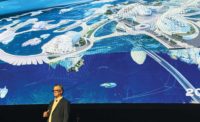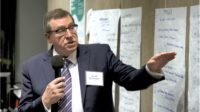The deadly coronavirus pandemic has not only caused contractors to temporarily halt projects and work differently, it also has caused construction professionals to imagine future changes to the built environment and to society in general.
The American Society of Civil Engineers began the effort before COVID-19, incorporating possible impacts from a global pandemic as part of its ambitious Future World Vision project to imagine future infrastructure systems. The project was unveiled last year in Miami.
The ongoing work explores a range of plausible future scenarios, based on the impacts of ongoing trends such as climate change and alternative energy. Additionally, the research project’s contributors factored in the effects of a pandemic into their calculations about future infrastructure systems, says Gerald (Jerry) Buckwalter, ASCE’s chief operating and strategy officer.
Buckwalter stresses that Future World Vision “is not about predicting the future. It's about teasing out all of the potential different future missions. You don't have to predict these things." Instead, people can model different scenarios and determine if current infrastructure systems will hold up in the future. “That's what makes society more resilient—it gives us time to think about options for the kinds of things we can't predict,” he adds.
Buckwalter says that some of the Future World Vision project's results forecasted for a pandemic “will now seem obvious,” since they have come about as a result of the coronavirus pandemic. Those include the quick establishment of an online work environment, which could have taken 20 or 30 years to develop without the influence of a pandemic, Buckwalter adds.
In the model, and in the real world, it happened at lightning speed. “Lo and behold, that's exactly what we saw happen. People adapted very quickly to different methods of working and communicating," he adds. It also raised the question of what to do for those on the other side of the digital divide who can't work that way? "That becomes very scary,” he says.
ENR recently got a chance to talk to Buckwalter about his views of the pandemic scenario before and after the real thing:
ENR: What other impacts did you see to future infrastructure systems in your modeling?
Buckwalter: The value tension between society wanting to promote public transportation for sustainability purposes—for being more green, getting cars off the road—would now be in tension with people who wouldn't want to be close to others. Maybe there's a balance between group transportation and driverless cars, for example, which allow some greater degree of social distancing but would be greener than people driving their (own) cars. So that was another implication that could affect civil engineering.
ENR: What other future developments did the team envision?
Buckwalter: We postulated that the use of robotics in construction would likely get accelerated and that regulatory safety clearances and hurdles would be cleared much faster. To get some infrastructure back on track you would want less people building it. So robotics could get accelerated.
ENR: How did the impact of a pandemic play out in the varying Future World concepts of future cities? (Resilient Cities; Progressive Mega Cities, Dispersed Settlements and Unequal Enclaves.)
Buckwalter: It played out in different ways. It had a much worse effect on the Mega City, for instance, where communal gatherings are the norm and therefore containing the spread of disease is really difficult. In the rural city, or Dispersed Settlement, a pandemic actually had a less deleterious effect on quality of life because they already had some measure of social separation.
The Megacities got hammered pretty hard … because society was geared more toward communal activity, and they were not as naturally set up for social distancing or teleworking as they were in other scenarios.
We also saw that, on the flip side, a rural city would struggle more with delivery of food and material. (On the other hand), in a Mega City, people would actually embrace driverless or robotic delivery of goods.
ENR: Did Future World Vision see any broader impacts from a pandemic?
Buckwalter: Following a pandemic, you might actually see that people's value systems improve because they revisit what's important in life and they become less superficial and stop being such frivolous consumers of goods.
[In this scenario,] they essentially become more resilient—their psyche becomes more resilient and hence their behavior becomes more resilient.
On the other hand, the research showed that you almost have an equal chance that it goes the opposite way. For instance, if you look at the 1918 Flu pandemic, it was followed by 10 years of the Roaring Twenties—incredibly frivolous communal behavior as the pent-up isolation and austerity measures lifted.
An interesting thing that we teased out in our analysis was that it was actually harder to predict the behavior of society in the 10 years following a crisis like a pandemic. It typically doesn't stay the same, but it could go one way or the other. It's really very unpredictable.






Post a comment to this article
Report Abusive Comment